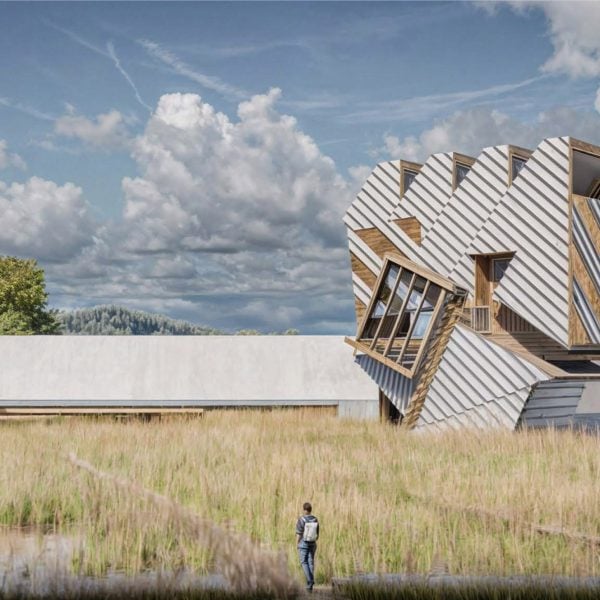Dezeen School Shows: a pavilion informed by the Bauhaus artist Paul Klee is included in Dezeen’s latest school show by students at Rensselaer Polytechnic Institute, the oldest technology research university in America.
Also included is a waterfront restoration project in New York, USA, and a gallery situated within a sculpture park.
Institution: Rensselaer Polytechnic Institute
School: School of Architecture
Courses: Architectural Design 1, First Year, Architectural Design 2, First Year, Architectural Design 4, Second Year, Vertical Design Studio, Third, Fourth and Fifth Year, Final Project, Fifth Year Thesis, Final Project, Fifth Year Thesis, Vertical Design Studio, Third, Fourth and Fifth Year, Architectural Design 3, Second Year
Tutors: Walaid Sehwail, Caleb White, Kyle Troyer, Adam Dayem, Crio Najle, Marcus Carter, Ryosuke Imaeda, Chris Perry, Riley Studebaker and Benjamin Vanmuysen
School statement:
“Situated within one of the premier technological research universities in the US, the School of Architecture at the Rensselaer Polytechnic Institute works in collaboration with leading scientists, engineers, technologists, artists and entrepreneurs.
“Together, we reimagine the future built environment as an ecologically responsive, energy-efficient, socially conscious and poetically charged constellation of buildings and infrastructures that reinvigorate and empower diverse communities around the world.
“We believe in the benevolent power of architecture to contribute to the environmental restoration of our planet, to establish a more productive, harmonious and symbiotic relationship with the natural world, and to imbue our buildings with an awe-inspiring sense of wonder and delight.”
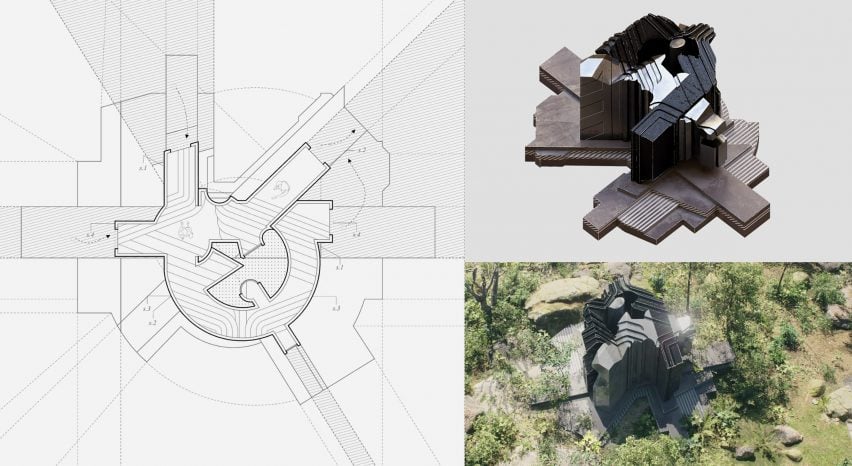
Figural Cohesion by Emma Tommell
“There exists a relationship between part-to-whole assemblies that focuses on how disjointed figural elements unify through graphic and at times elegant pattern overlays; specifically systemised gradient patterns visually tying fragmented parts together.
“Series of figural volumes were created and nestled together to produce a larger disjointed whole – while in parallel a series of graphic patterns were produced to drape onto the whole assembly, to form a tension between the disordered figural parts and systemised order of the graphic patterns.
“Dissonance is resolved through altering the graphic patterns into gradient patterns and material transitions that visually unify the different parts into a cohesive whole.
“Additionally, duality exists between the similar patterns utilised either as flat graphic patterns on the ground plane or as relief patterns in the volumetric figures, that introduce machine-like aesthetics due to material effect from the relief introduced.
“These patterns, influenced by materiality, blur the lines between two-dimensional graphic representation and three-dimensional, machined precision. The result is a design where flatness and industrial reliefs coexist, challenging conventional perceptions and enhancing the sense of visual complexity.
“This tension between graphic flatness and mechanical texture highlights the project’s exploration of contrast and cohesion.”
Student: Emma Tommell
Course: Architectural Design 2, First Year
Tutor: Walaid Sehwail
Email: tommee[at]rpi.edu
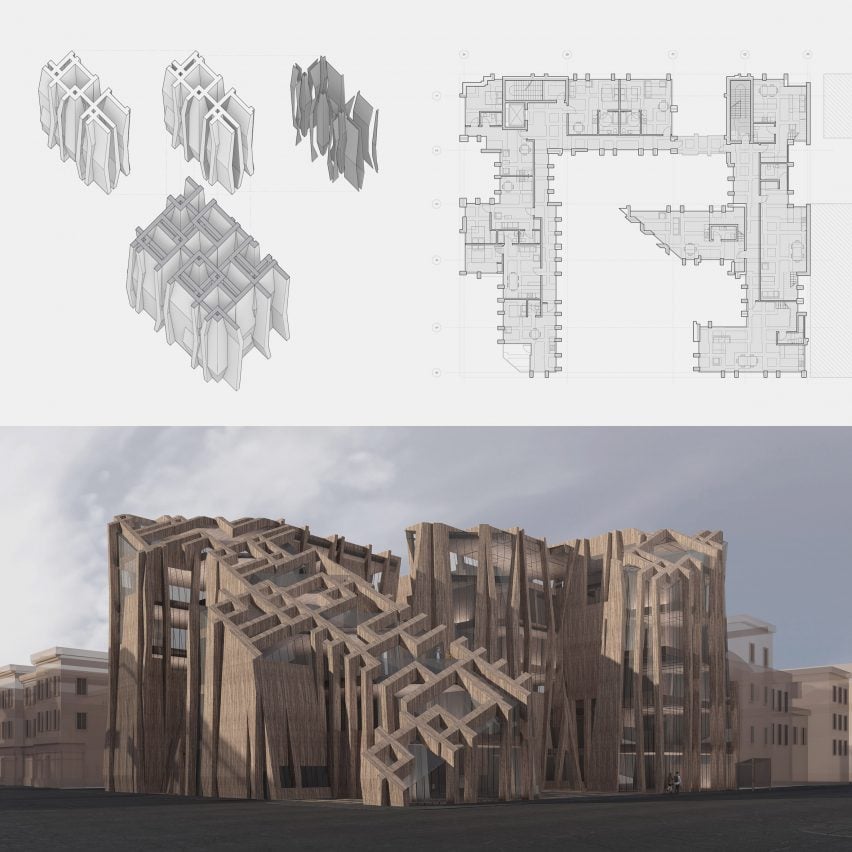
New Spatial Matrices for Housing by Allison Motler and Katherine Wright
“In this housing studio, students developed novel spatial matrices to resist the normative tendencies of apartment blocks to become highly repetitive floors connected by vertical structure.
“Complexities introduced by these matrices provided a framework in which to resolve program and spatial networks as support for social relationships within and adjacent to the housing project.
“Students developed these spatial matrices in a two-stage modelling process intended to take advantage of digital thinking, while also layering in a specific type of indeterminacy enabled by a structuralist critique of modernism.
The first stage of modelling started with two parametrically controlled digital models, one exploring the overall figure of the building, and another exploring an aggregation of an abstract repetitive unit.
“In the second stage of modelling students were asked to move away from a direct link between a digital input and a spatial idea.
“They were asked to make one model that brought the large scale of the overall building figure model together with the small scale of the repetitive unit, and another that looked at a portion of the building in detail. They were required to negotiate the indeterminate complexities of combining architectural scales and details expressing the collective nature of the building.”
Students: Allison Motler and Katherine Wright
Course: Architectural Design 4, Second Year
Tutor: Adam Dayem
Emails: motlea[at]rpi.edu and wrighk4[at]rpi.edu
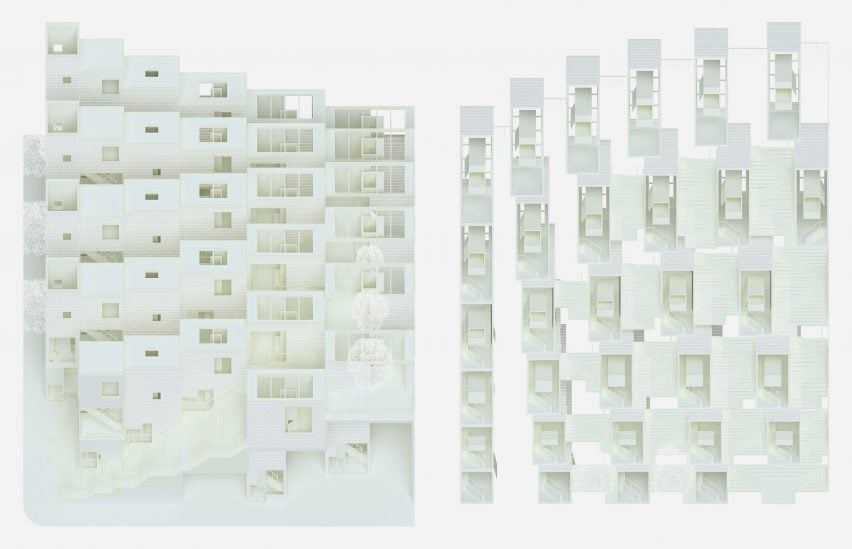
Fading Domino Towers by Ryan Bedell and Hannah Taylor
“What happens with the canon in architecture when its alleged norm, which defines the status quo of architecture as we know it, is heretically merged with the orthodoxy of another canon, an uncanny integration is stretched beyond the standards of its predecessors, through a pliant but inertial rule set of variations?
“By configuring complex architectural artefacts through integration and differentiation, the creativity of the normative is driven to arise out of the normal, the singular out of the dogmatic and the profane out of the sacred, constituting architectural models that, while strictly rooted in history, turn history upside down.
“Hypercanon engenders offbeat forms of canon through the saturated promiscuity of existing ones, disputing the architectural canon from within through abstraction, mixture, variation and redundancy.
“Fading Domino Towers is a housing gradient field that integrates the amusingly non-repetitive Seijo Town Houses, by Kazuyo Sejima and the obsessively regularly repetitive Carabanchel Housing bar, by the architects formerly known as FOA.
“While constituting vastly disparate approaches to collective residential living, the former operating as a seemingly random field of delicately displaced minute single space units that subtly change in height and width, creating pockets and paths of common space and the latter configuring an extremely long six-story building that minimises public space to optimise private space.
“Fading Domino Towers transitions their organisation and rationality in a field with a wide variety of minimum existence and joyful living housing units that merge the radical and the playful in an apparent architectural oxymoron.”
Students: Ryan Bedell and Hannah Taylor
Course: Architectural Design 4, Second Year
Tutor: Crio Najle
Emails: bedelr2[at]rpi.edu and tayloh[at]rpi.edu
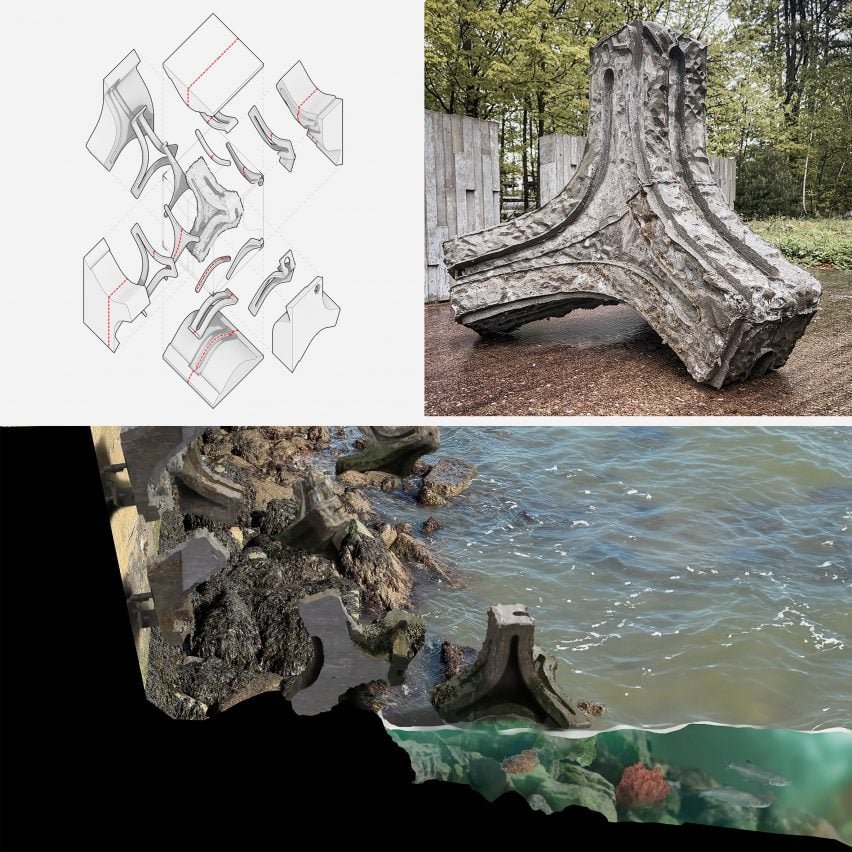
Y-Wave by Ethan Aspiras and Marcus Morgan
“This studio focused on design and construction of ecological coastal armouring units and sea wall panels, to be installed in the intertidal zone along the shoreline of Governors Island in New York City.
“Working with The Fort Miller Group, a precast concrete fabricator located in Greenwich, New York, students engaged in digital and material fabrication to realise their proposals.
“The work considered a range of issues including urban ecology, waterfront restoration, material science and advanced fabrication techniques.
“This proposal focused on varied surface rugosity, understanding tidal zones, regulating surface temperature, providing erosion protection and increasing vegetation as a nursery for various species.
“It considered three scales of efficacy: the overall mass and how it aggregates with other units or existing riprap, a middle scale of texture for juvenile species to inhabit in small pools and the micro-texture for algae, bacteria and other tiny organisms. CNC milled molds with silicone form liners were created to cast the geometries in concrete.”
Student: Ethan Aspiras and Marcus Morgan
Course: Vertical Design Studio, Third, Forth and Fifth Year
Tutor: Marcus Carter
Email: aspire[at]rpi.edu and morgam13[at]rpi.edu
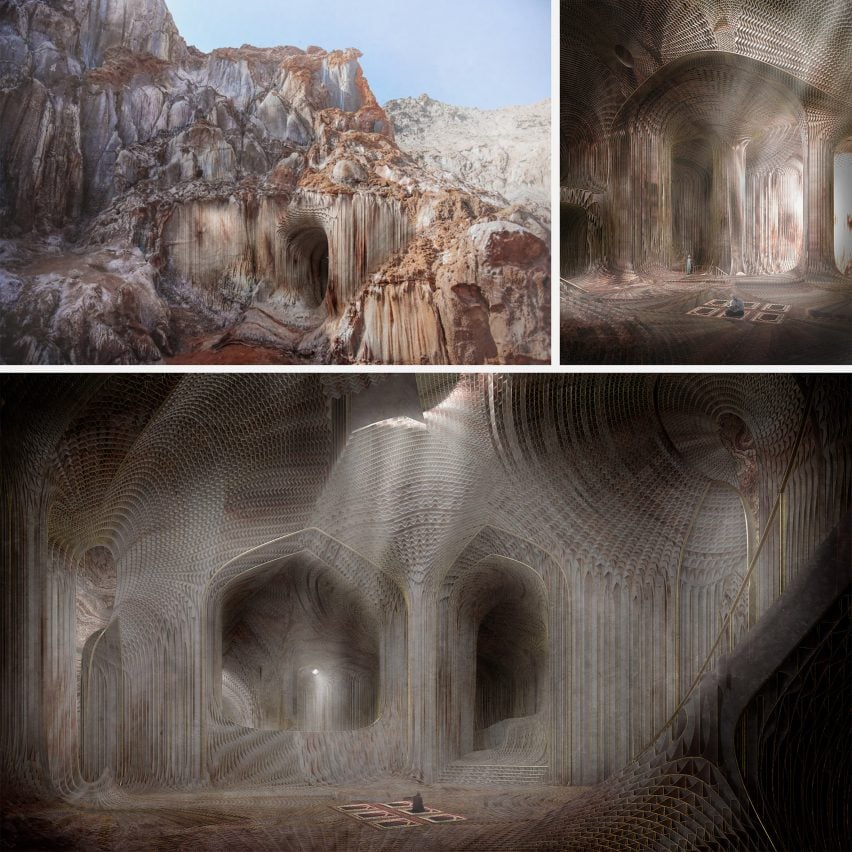
Breaths and Echoes: Carving Spaces in Time by Clara Cruz
“In today’s rapidly changing world, stillness has shifted its definition from a stationary to that which torpidly mutates beyond our perception.
“We appreciate both the dynamic nature of society and the stacicity of artefacts – within the paradigm, objects continue to evolve, affording the awe and wonder of past events inscribed in their timeless existence.
“Located on Hormuz Island, an island entirely formed from a salt dome embedded in clay, this project offers spaces for miners, worshippers and caregivers. By reclaiming land scarred by material extraction, the space adapts to cultural needs, allowing local skills and traditions to persist. As workers carve the land, the salt mine transforms into a mosque.
“Although excavation is driven by economic reasons to benefit from mineral trade, the ongoing process gradually reveals spaces by finding what can be carved and what must remain structural. The discovery of specific bedrocks also forges halotherapy chambers for respiratory treatment.
“In the absence of blueprints, architecture becomes a process of archaeological discovery. Traces of human interaction – touches, climbs, footprints, scratched surfaces, drill marks and exposed bedrock – are all integral to the formation of these spaces. Tangential to existing nature and its demand, the project views design as a tactile dialogue with materials, thereby loosely operating between the land and the space.”
Student: Clara Cruz
Course: Final Project, Fifth Year Thesis
Tutor: Ryosuke Imaeda
Email: clara.alho.cruz[at]gmail.com
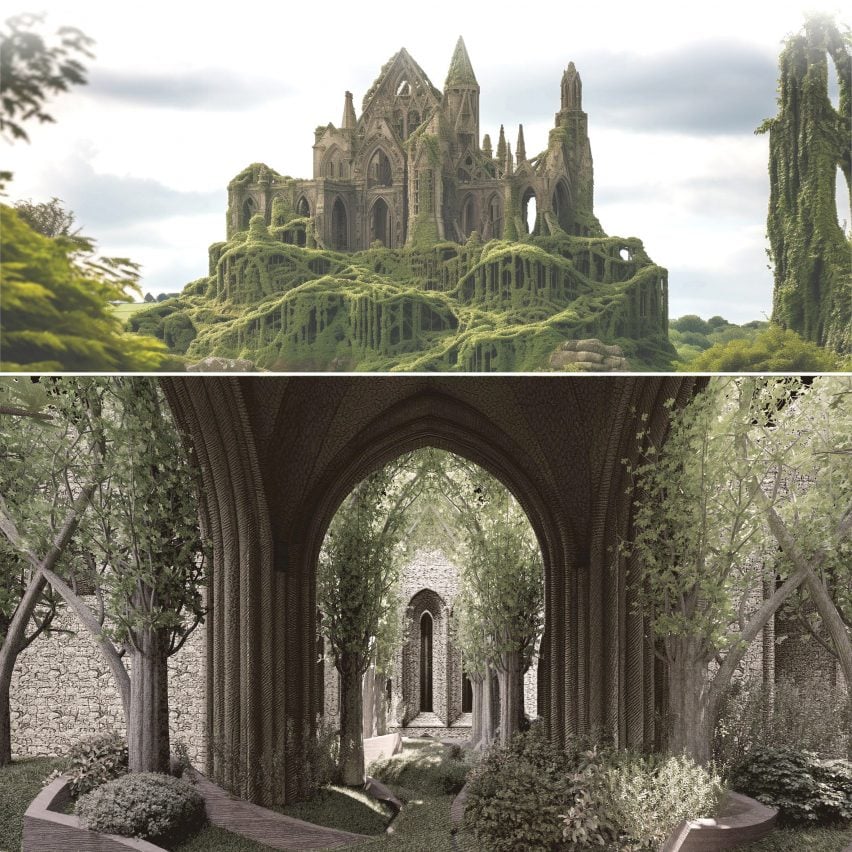
The Arborous Ruin by Sami Detwiler
“This thesis engages our final project section prompt of ambiguous territory through an exploration of ambiguities regarding the relationship between architecture and nature, in terms of the discipline’s origin story, as rooted in the natural, as well as qualities of permanence and impermanence; while architecture has historically aspired to the former, the natural environment exemplifies the latter.
“To this extent, the architectural ruin became a point of interest, in terms of its ambiguous status as situated somewhere between such conditions; at once architectural and natural (given the emergence of plant and wildlife in lieu of human inhabitation), as well as permanent and impermanent (given the building’s gradual erosion in lieu of regular maintenance).
“Additionally, the ruin introduces ambiguities regarding its status as being situated between the past and the present; at once a monument to history, the ruin continues to function, albeit in new and unexpected ways.”
Student: Sami Detwiler
Course: Final Project, Fifth Year Thesis
Tutor: Chris Perry
Email: samidetwiler[at]gmail.com
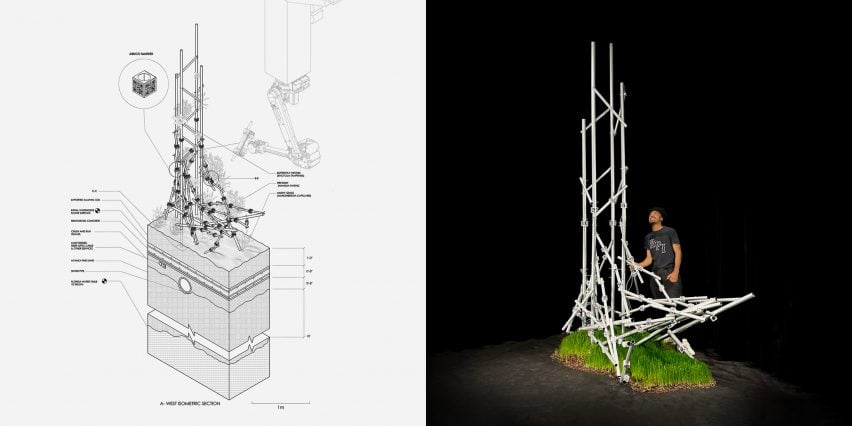
FloraForge: Slow Autonomy for Ecological Husbandry by Colin Bentley, Colin Dorsey and Bryn Peterson
“In 2023, led by Professor Riley Studebaker, Rensselaer Architecture students utilised robotic-arm and mixed-reality fabrication to develop a full-scale structural prototype for non-humans.
“Students Bryn Peterson, Collin Bentley and Collin Dorsey envisioned speculative futures of post-human Florida, proposing the use of embedded robotics in Amazon Mega-Fulfillment centres as autonomous labor for adaptive reuse.
“The project functioned both as a thought experiment and an R&D prototype; the team imagined how robotics can intersect with adaptive reuse and non-human ecologies and then literally constructed a ‘live’ prototype to demonstrate its fabrication and operation.
“The team’s prototype, built from bolted EMT steel, was assembled using an ABB robotic arm and a Hololense 2 mixed-reality headset with Fologram. Sensors embedded in the structure monitored and directed the growth of Dactylis glomerata grass by autonomously controlling soil moisture, temperature, and light levels.
“Now permanently displayed in the RPI Folsom Library, prototypes from the studio serve as templates for future students in robotic design. By integrating robotic labour into adaptive reuse, the studio has reinforced the Rensselaer School of Architecture’s innovative approach to technology, not only teaching the technical operation of emerging tools, but also exploring the meaningful and responsible impacts of those emerging tools in the built environment.
Students: Colin Bentley, Colin Dorsey and Bryn Peterson
Course: Vertical Design Studio, Third, Fourth and Fifth Year
Tutor: Riley Studebaker
Emails: bentlc[at]rpi.edu, dorsec2[at]rpi.edu and peterb5[at]rpi.edu
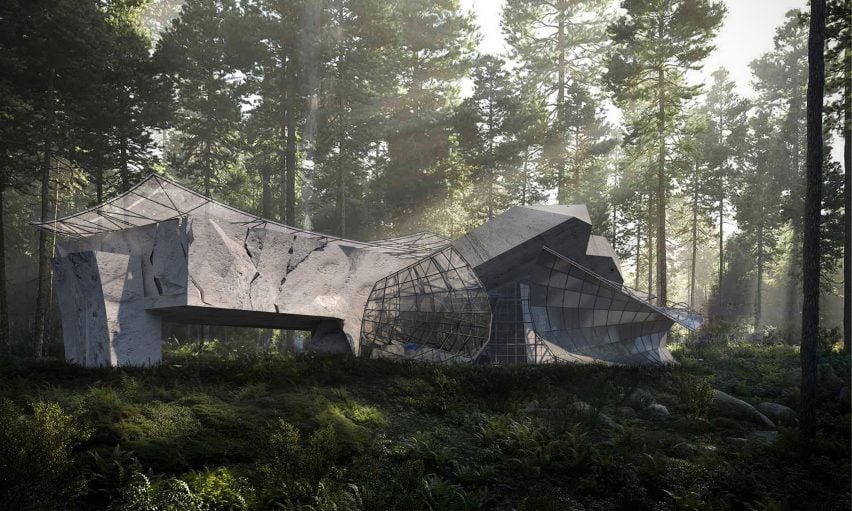
Violated Perfection by Jack Zhang
Situated within the Art OMI arts centre in the Hudson Valley, this studio project connects the institution’s artist residencies with its sculpture park.
“The proposed gallery offers an exhibition space within the public park for artists to display their work produced during the residency.
“As such, the gallery doesn’t only provide a container for art display, but also a contribution to the sculpture park.
Exhausted by the impervious search for perfection, this project embraces the inherent beauty of spontaneity, discontinuity and misalignment.
“The main entrance of the project is articulated with two warped surfaces which emphasise the connection between the gallery and the ground.
“While the entrance is ductile, the exterior is clad with broken and fragmented pieces of concrete, creating light crevasses to illuminate the exhibition space.
“The project intentionally disrupts the traditional perception of a gallery to not only enhance the experience of its visitors, but also to stimulate its art residents.”
Student: Jack Zhang
Course: Architectural Design 3, Second Year
Tutor: Benjamin Vanmuysen
Email: zhangj49[at]rpi.edu
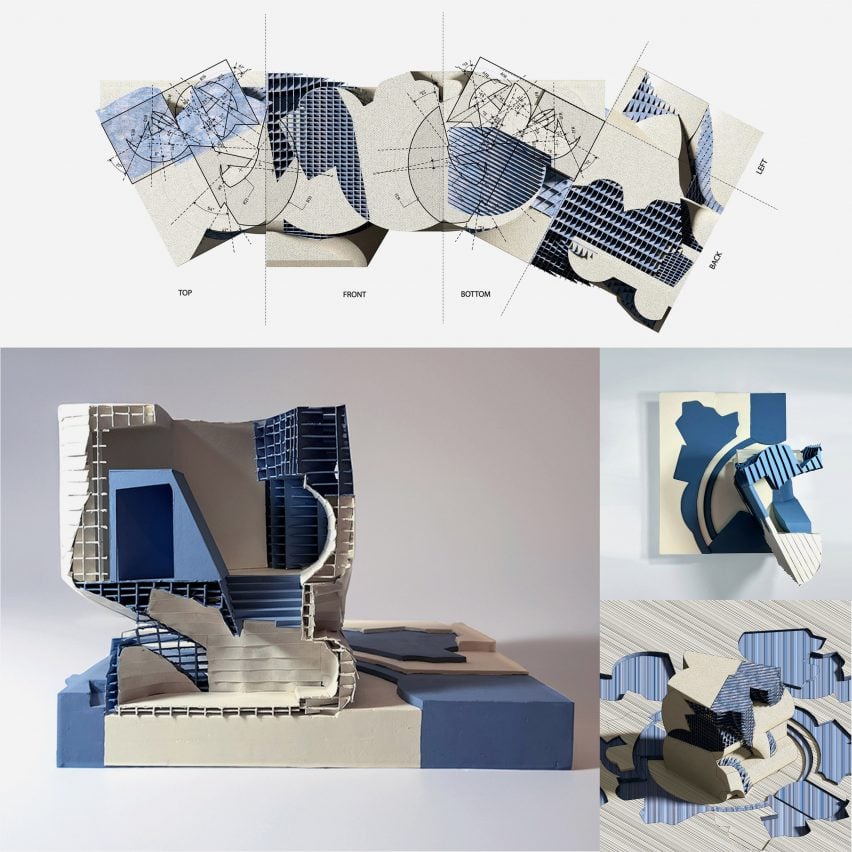
Ambiguous Figures by Natalie Simpson
This project began with a formal analysis of an artwork by Paul Klee from his book, The Thinking Eye.
“Students were challenged to excavate figures from the multiplicity of possible readings and then to recompose these figures into their own compositions.
“Ambiguous Figures relies on the simultaneity that emerges from provoking the extracted figures into three-dimensional space, and then through orthographic projection, muddling and blurring their relationships to create rich and interdependent spatial relationships.
“This formal agenda is brought to bear on a small two-story pavilion which students were asked to model with multiple materials and strategies of assembly.
“This project contemplates the capacity of our perception to read simultaneous and sometimes conflicting forms and to untangle these into a coherent spatial reading.”
Student: Natalie Simpson
Course: Architectural Design 1, First Year
Tutor: Caleb White
Email: simpsn[at]rpi.edu
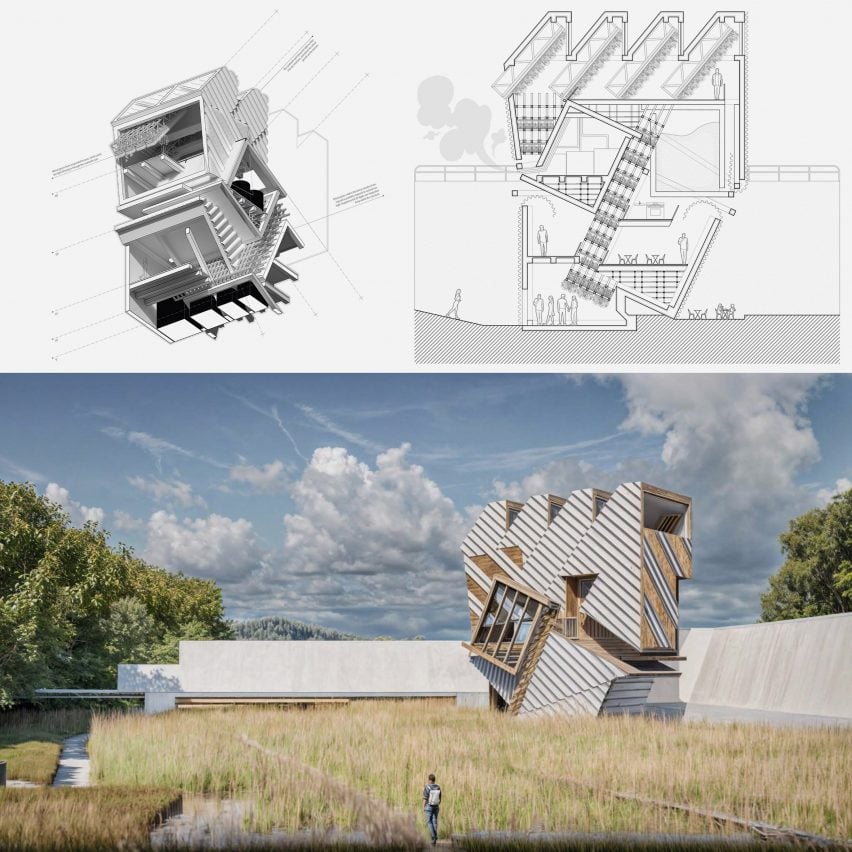
Grain Stack by Sofia Amato
“The project site, located at Lock E17 in Little Falls, New York, encouraged students to explore the themes of water flow and containment and the integration of non-human occupants.
“Given the Erie Canal’s historical role in transporting agricultural products such as wheat and corn, the studio brief called for the design of a granary hybridised with a bakery to facilitate a connection to the public, with the non-human occupant for this studio conceptualised as wheat and other commonly farmed crops.
“Granaries, as ubiquitous agrarian typologies, were studied to examine dichotomies such as nature versus architecture, the raw versus the synthetic and functionalism versus inefficiency.
“Students investigated informal geometric relationships that referenced found granaries and how residual spaces emerge through stacking, peeling, shifting, leaning and intersecting simple forms.
“This project consists of cubic volumes that shift and misalign to create dynamic spaces for both agriculture and human use. The residual gaps allow natural light to penetrate the interior, welcoming crop farming inside the building. The design explores how basic volumes can produce spatial complexity, blending utility with an expression of an agrarian aesthetic.”
Student: Sofia Amato
Course: Architectural Design 2, First Year
Tutor: Kyle Troyer
Email: amatos[at]rpi.edu
Partnership content
This school show is a partnership between Dezeen and Rensslear Polytechnic University. Find out more about Dezeen partnership content here.

